Abstract
The pattern of episodic gonadotropin release was studied in 15 normal female volunteers during the luteal phase of the menstrual cycle with 24 h of blood sampling for follicle-stimulating hormone (FSH) and luteinizing hormone (LH) levels at 10-min intervals. Six subjects (two in the early, two in the mid-, and two in the late luteal phase) also had each of these specimens processed for progesterone levels. A progressive slowing of LH pulsations was present across the luteal phase with the mean LH pulse frequency declining from 15.2 pulses/24 h in the early to 8.4/24 h in the late luteal phase. A trend towards reduction in the amplitude of LH pulses was also observed (12.3 +/- 2.2 SD mIU/ml in the early vs. 8.6 +/- 3.4 mIU/ml in the late luteal phase; NS). In addition, LH pulses of heterogeneous amplitude were identified during the same 24-h study. The mean +/- SD of the larger and of the smaller LH pulses was 16.9 +/- 4.7 and 2.3 +/- 1.0 mIU/ml, respectively (P less than 0.001). While the slowing of the frequency of all LH pulses correlated well (r = 0.80, P less than 0.001) with the day of the luteal phase and poorly with the actual plasma progesterone levels, the incidence of the small LH pulses was highest in the mid-luteal phase and correlated well with the mean progesterone plasma levels (r = 0.63, P less than 0.01). In the early luteal phase, the pattern of progesterone secretion was stable over the 24-h studies and showed no relationship to episodic LH release. In contrast, in the mid- and late luteal phase, plasma progesterone concentrations rapidly fluctuated during the 24-h studies from levels as low as 2.3 to peaks of 40.1 ng/ml, often within the course of minutes. Progesterone increments closely attended episodes of LH release, as documented by the significant (P less than 0.05) cross-correlation between LH and progesterone levels, at time lags of 25-55 min. The results of this study indicate that in the human luteal phase: (a) the frequency of pulsatile release of LH declines progressively and correlates well with the duration of exposure to progressively and correlates well with the duration of exposure to progesterone; (b) the amplitude of LH pulses varies with the appearance of an increased percentage of smaller pulses correlating well with the acute level of progesterone; (c) in the early luteal phase, the pattern of progesterone secretion is stable; (d) in the mid- and late luteal phase, progesterone secretion is episodic, and correlates with LH pulsatile release; and (e) single progesterone estimations in the mid- and late luteal phase do not accurately reflect corpus luteum adequacy.
Full text
PDF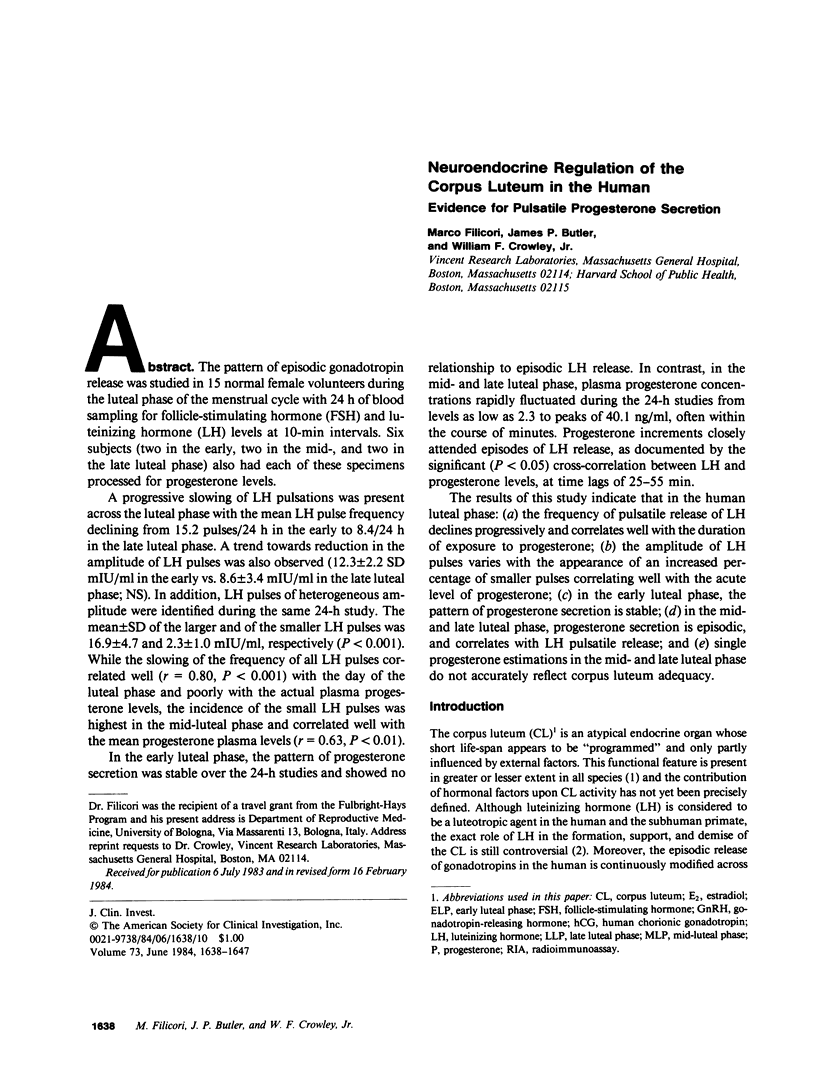
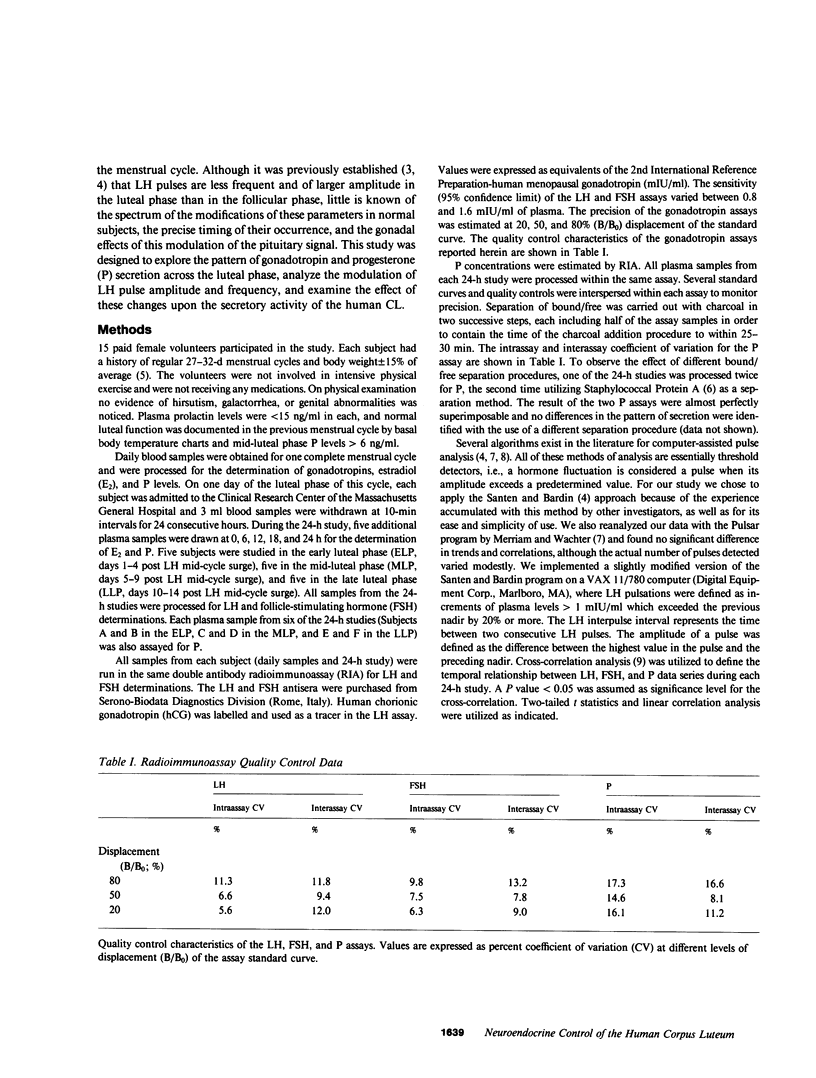
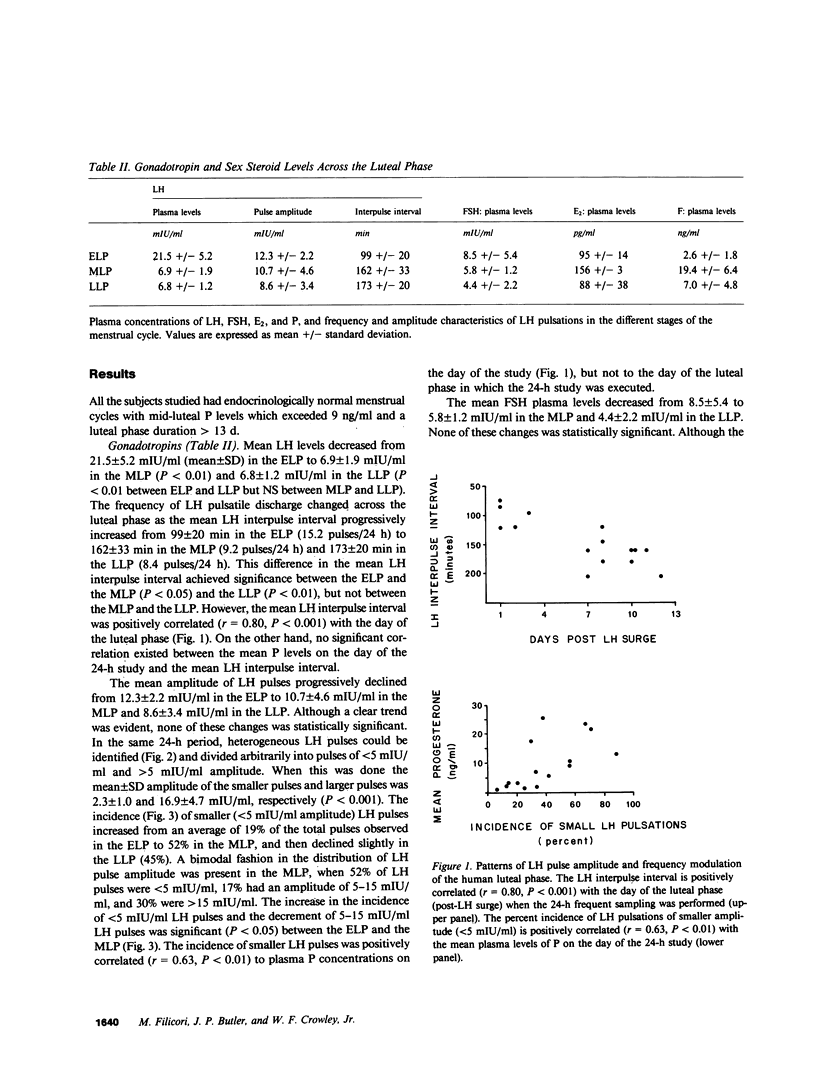
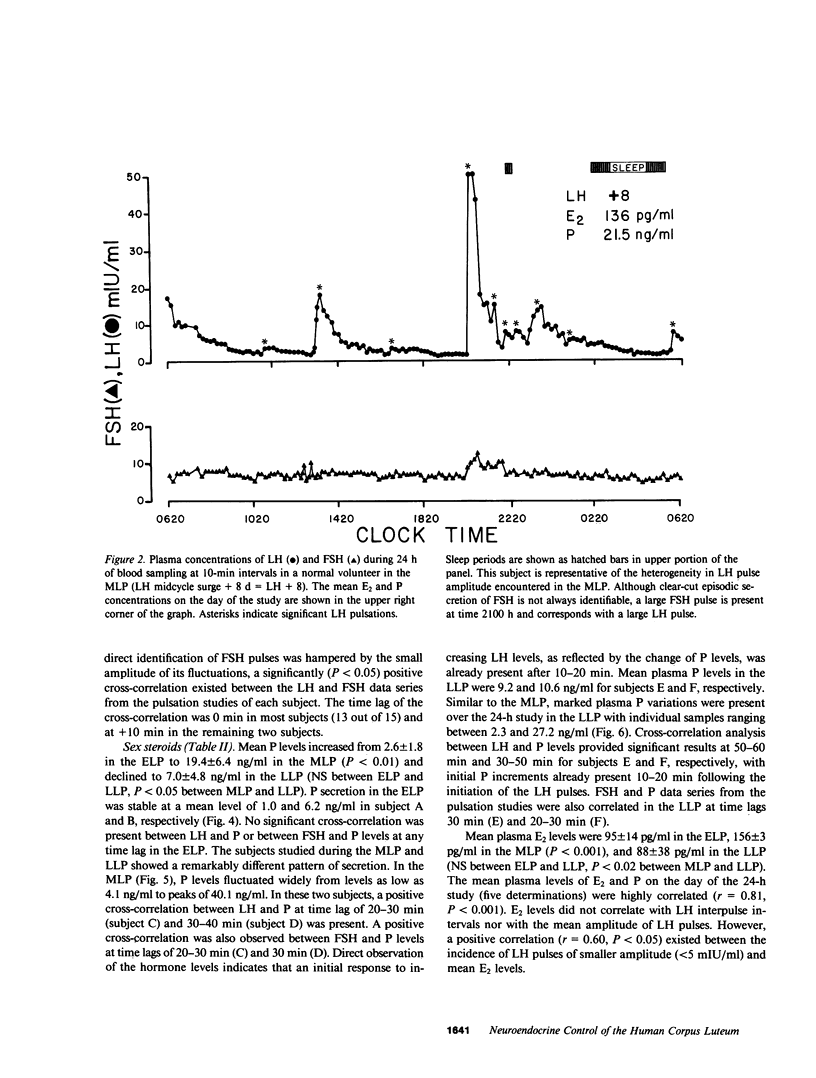
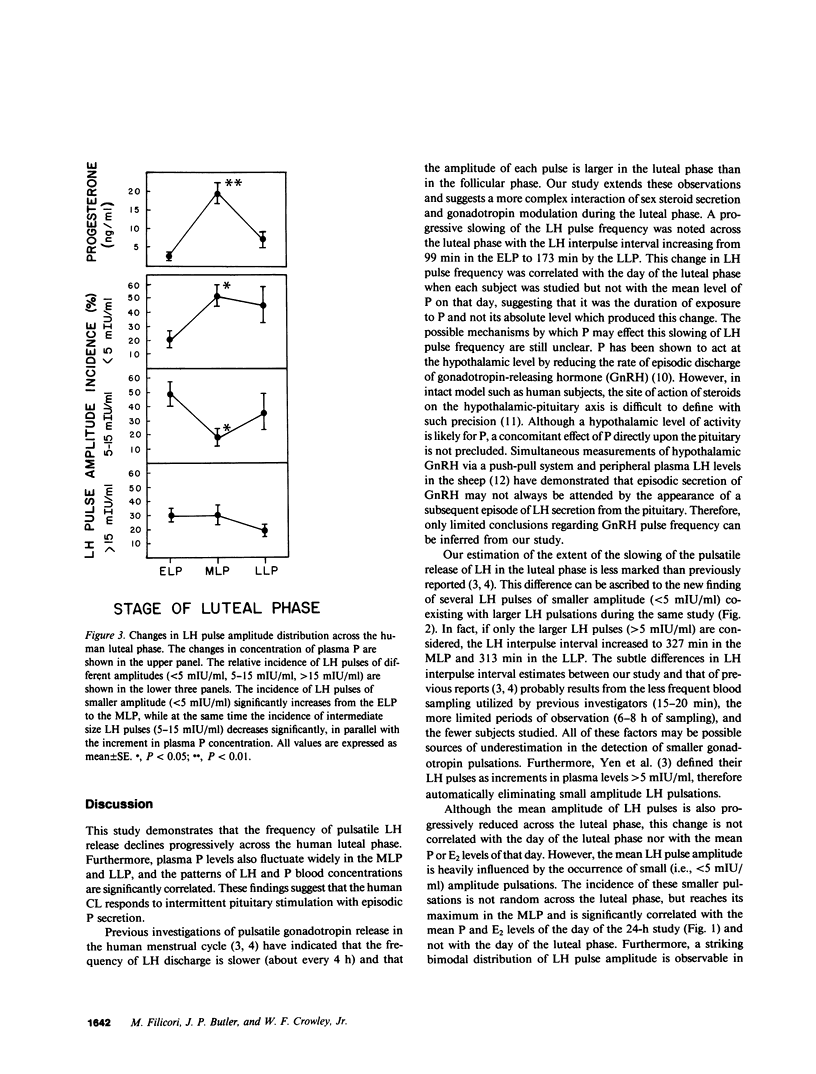
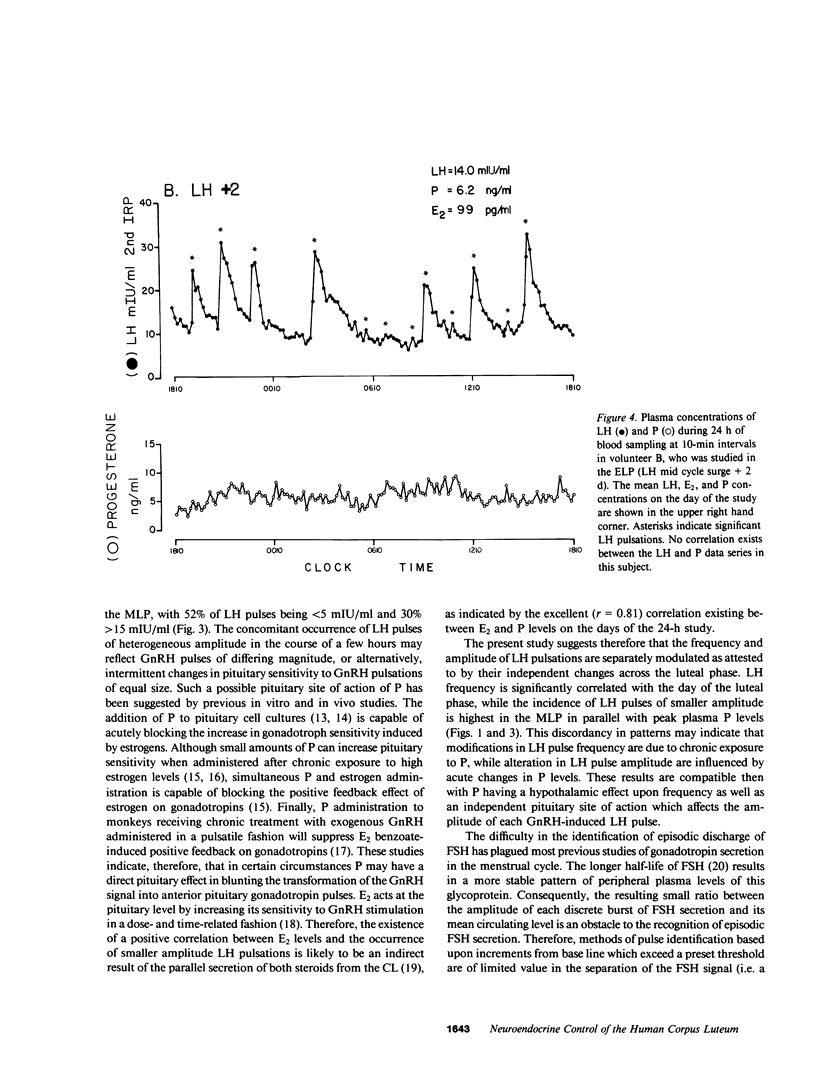
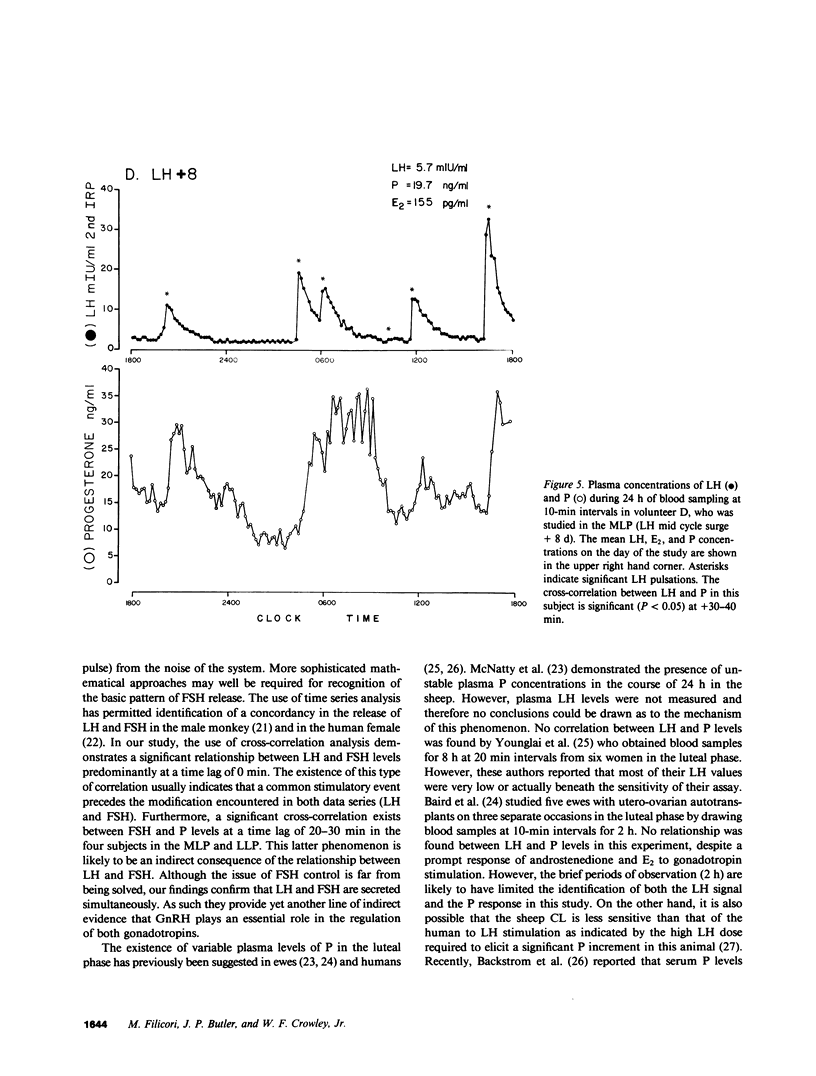
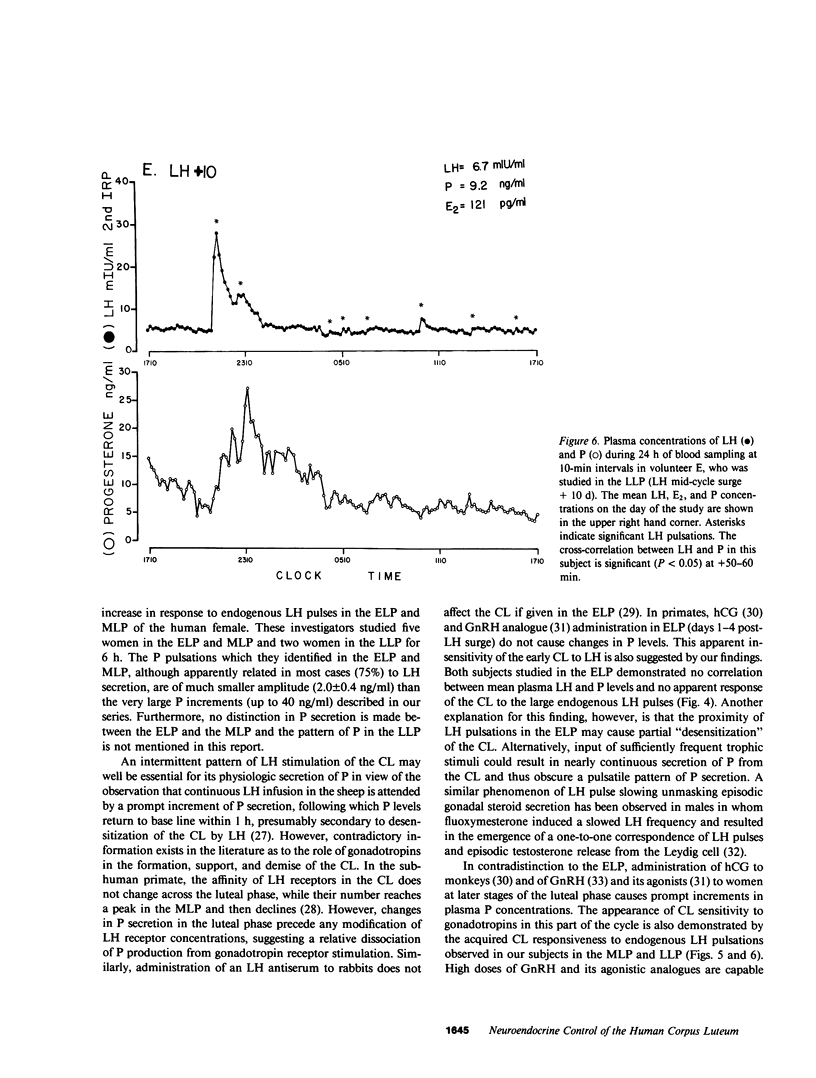

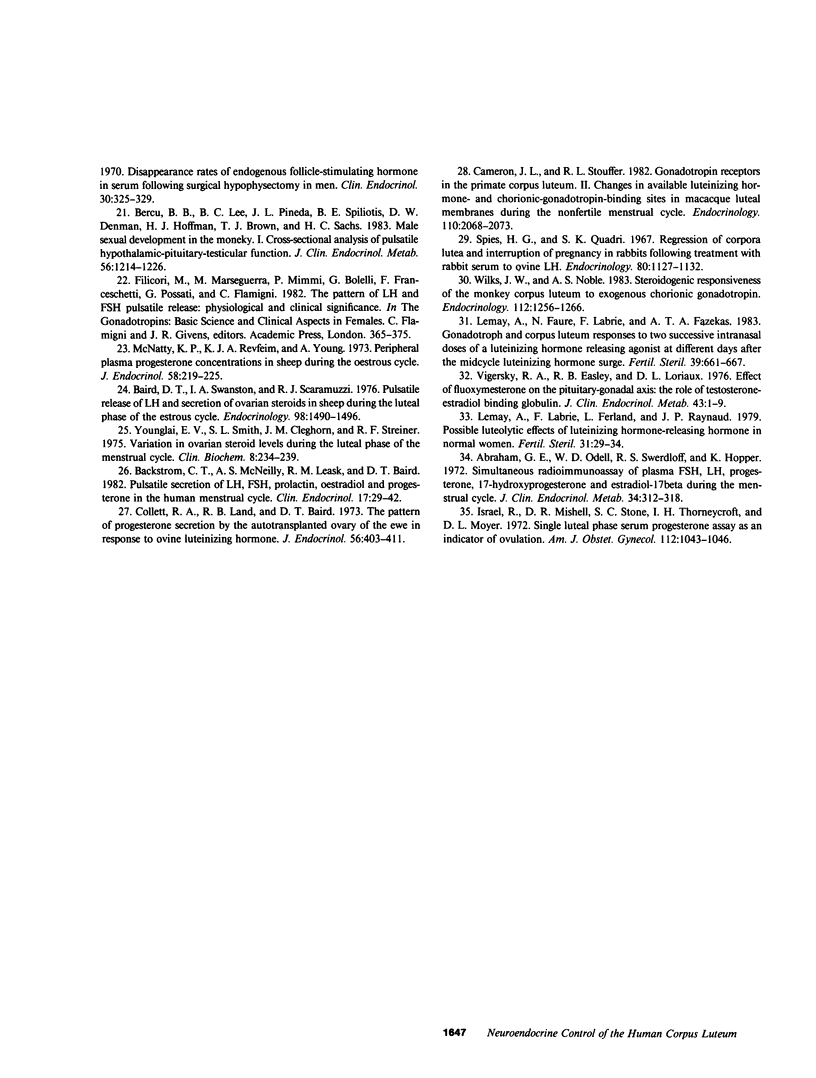
Selected References
These references are in PubMed. This may not be the complete list of references from this article.
- Abraham G. E., Odell W. D., Swerdloff R. S., Hopper K. Simultaneous radioimmunoassay of plasma FSH, LH, progesterone, 17-hydroxyprogesterone, and estradiol-17 beta during the menstrual cycle. J Clin Endocrinol Metab. 1972 Feb;34(2):312–318. doi: 10.1210/jcem-34-2-312. [DOI] [PubMed] [Google Scholar]
- Aedo A. R., Pedersen P. H., Pedersen S. C., Diczfalusy E. Ovarian steroid secretion in normally menstruating women. II. The contribution of the corpus luteum. Acta Endocrinol (Copenh) 1980 Oct;95(2):222–231. doi: 10.1530/acta.0.0950222. [DOI] [PubMed] [Google Scholar]
- Baird D. T., Swanston I., Scaramuzzi R. J. Pulsatile release of LH and secretion of ovarian steroids in sheep during the luteal phase of the estrous cycle. Endocrinology. 1976 Jun;98(6):1490–1496. doi: 10.1210/endo-98-6-1490. [DOI] [PubMed] [Google Scholar]
- Balmaceda J. P., Borghi M. R., Coy D. H., Schally A. V., Asch R. H. Suppression of postovulatory gonadotropin levels does not affect corpus luteum function in rhesus monkeys. J Clin Endocrinol Metab. 1983 Oct;57(4):866–868. doi: 10.1210/jcem-57-4-866. [DOI] [PubMed] [Google Scholar]
- Bercu B. B., Lee B. C., Pineda J. L., Spiliotis B. E., Denman D. W., 3rd, Hoffman H. J., Brown T. J., Sachs H. C. Male sexual development in the monkey. I. Cross-sectional analysis of pulsatile hypothalamic-pituitary-testicular function. J Clin Endocrinol Metab. 1983 Jun;56(6):1214–1226. doi: 10.1210/jcem-56-6-1214. [DOI] [PubMed] [Google Scholar]
- Bäckström C. T., McNeilly A. S., Leask R. M., Baird D. T. Pulsatile secretion of LH, FSH, prolactin, oestradiol and progesterone during the human menstrual cycle. Clin Endocrinol (Oxf) 1982 Jul 1;17(1):29–42. doi: 10.1111/j.1365-2265.1982.tb02631.x. [DOI] [PubMed] [Google Scholar]
- Cameron J. L., Stouffer R. L. Gonadotropin receptors of the primate corpus luteum. II. Changes in available luteinizing hormone- and chorionic gonadotropin-binding sites in macaque luteal membranes during the nonfertile menstrual cycle. Endocrinology. 1982 Jun;110(6):2068–2073. doi: 10.1210/endo-110-6-2068. [DOI] [PubMed] [Google Scholar]
- Clifton D. K., Steiner R. A. Cycle detection: a technique for estimating the frequency and amplitude of episodic fluctuations in blood hormone and substrate concentrations. Endocrinology. 1983 Mar;112(3):1057–1064. doi: 10.1210/endo-112-3-1057. [DOI] [PubMed] [Google Scholar]
- Collett R. A., Land R. B., Baird D. T. The pattern of progesterone secretion by the autotransplanted ovary of the ewe in response to ovine luteinizing hormone. J Endocrinol. 1973 Mar;56(3):403–411. doi: 10.1677/joe.0.0560403. [DOI] [PubMed] [Google Scholar]
- Drouin J., Labrie F. Interactions between 17 beta-estradiol and progesterone in the control of luteinizing hormone and follicle-stimulating hormone release in rat anterior pituitary cells in culture. Endocrinology. 1981 Jan;108(1):52–57. doi: 10.1210/endo-108-1-52. [DOI] [PubMed] [Google Scholar]
- Goodman R. L., Karsch F. J. Pulsatile secretion of luteinizing hormone: differential suppression by ovarian steroids. Endocrinology. 1980 Nov;107(5):1286–1290. doi: 10.1210/endo-107-5-1286. [DOI] [PubMed] [Google Scholar]
- Israel R., Mishell D. R., Jr, Stone S. C., Thorneycroft I. H., Moyer D. L. Single luteal phase serum progesterone assay as an indicator of ovulation. Am J Obstet Gynecol. 1972 Apr 15;112(8):1043–1046. doi: 10.1016/0002-9378(72)90178-0. [DOI] [PubMed] [Google Scholar]
- Kamel F., Krey L. C. Gonadal steroid modulation of LHRH-stimulated LH secretion by pituitary cell cultures. Mol Cell Endocrinol. 1982 Apr;26(1-2):151–164. doi: 10.1016/0303-7207(82)90013-2. [DOI] [PubMed] [Google Scholar]
- Lasley B. L., Wang C. F., Yen S. S. The effects of estrogen and progesterone on the functional capacity of the gonadotrophs. J Clin Endocrinol Metab. 1975 Nov;41(5):820–826. doi: 10.1210/jcem-41-5-820. [DOI] [PubMed] [Google Scholar]
- Lemay A., Faure N., Labrie F., Fazekas A. T. Gonadotroph and corpus luteum responses to two successive intranasal doses of a luteinizing hormone-releasing hormone agonist at different days after the midcycle luteinizing hormone surge. Fertil Steril. 1983 May;39(5):661–667. doi: 10.1016/s0015-0282(16)47062-7. [DOI] [PubMed] [Google Scholar]
- Lemay A., Labrie F., Ferland L., Raynaud J. P. Possible luteolytic effects of luteinizing hormone-releasing hormone in normal women. Fertil Steril. 1979 Jan;31(1):29–34. doi: 10.1016/s0015-0282(16)43755-6. [DOI] [PubMed] [Google Scholar]
- Levine J. E., Pau K. Y., Ramirez V. D., Jackson G. L. Simultaneous measurement of luteinizing hormone-releasing hormone and luteinizing hormone release in unanesthetized, ovariectomized sheep. Endocrinology. 1982 Nov;111(5):1449–1455. doi: 10.1210/endo-111-5-1449. [DOI] [PubMed] [Google Scholar]
- March C. M., Goebelsmann U., Nakamura R. M., Mishell D. R., Jr Roles of estradiol and progesterone in eiliciting the midcycle luteinizing hormone and follicle-stimulating hormone surges. J Clin Endocrinol Metab. 1979 Oct;49(4):507–513. doi: 10.1210/jcem-49-4-507. [DOI] [PubMed] [Google Scholar]
- McNatty K. P., Revefeim K. J., Young A. Peripheral plasma progesterone concentrations in sheep during the oestrous cycle. J Endocrinol. 1973 Aug;58(2):219–225. doi: 10.1677/joe.0.0580219. [DOI] [PubMed] [Google Scholar]
- Merriam G. R., Wachter K. W. Algorithms for the study of episodic hormone secretion. Am J Physiol. 1982 Oct;243(4):E310–E318. doi: 10.1152/ajpendo.1982.243.4.E310. [DOI] [PubMed] [Google Scholar]
- Padmanabhan V., Convey E. M. Progesterone inhibits the ability of estradiol to increase basal and luteinizing hormone-releasing hormone-induced luteinizing hormone release from bovine pituitary cells in culture: neither progesterone nor estradiol affects follicle-stimulating hormone release. Endocrinology. 1981 Oct;109(4):1091–1096. doi: 10.1210/endo-109-4-1091. [DOI] [PubMed] [Google Scholar]
- Pohl C. R., Richardson D. W., Marshall G., Knobil E. Mode of action of progesterone in the blockade of gonadotropin surges in the rhesus monkey. Endocrinology. 1982 Apr;110(4):1454–1455. doi: 10.1210/endo-110-4-1454. [DOI] [PubMed] [Google Scholar]
- Rothchild I. The regulation of the mammalian corpus luteum. Recent Prog Horm Res. 1981;37:183–298. doi: 10.1016/b978-0-12-571137-1.50009-8. [DOI] [PubMed] [Google Scholar]
- SARGENT D. W. WEIGHT-HEIGHT RELATIONSHIP OF YOUNG MEN AND WOMEN. Am J Clin Nutr. 1963 Nov;13:318–325. doi: 10.1093/ajcn/13.5.318. [DOI] [PubMed] [Google Scholar]
- Santen R. J., Bardin C. W. Episodic luteinizing hormone secretion in man. Pulse analysis, clinical interpretation, physiologic mechanisms. J Clin Invest. 1973 Oct;52(10):2617–2628. doi: 10.1172/JCI107454. [DOI] [PMC free article] [PubMed] [Google Scholar]
- Spies H. G., Quadri S. K. Regression of corpora lutea and interruption of pregnancy in rabbits following treatment with rabbit serum to ovine LH. Endocrinology. 1967 Jun;80(6):1127–1132. doi: 10.1210/endo-80-6-1127. [DOI] [PubMed] [Google Scholar]
- Vigersky R. A., Easley R. B., Loriaux D. L. Effect of fluoxymesterone on the pituitary-gonadal axis: the role of testosterone-estradiol-binding globulin. J Clin Endocrinol Metab. 1976 Jul;43(1):1–9. doi: 10.1210/jcem-43-1-1. [DOI] [PubMed] [Google Scholar]
- Wilks J. W., Noble A. S. Steroidogenic responsiveness of the monkey corpus luteum to exogenous chorionic gonadotropin. Endocrinology. 1983 Apr;112(4):1256–1266. doi: 10.1210/endo-112-4-1256. [DOI] [PubMed] [Google Scholar]
- Yen S. S., Tsai C. C., Naftolin F., Vandenberg G., Ajabor L. Pulsatile patterns of gonadotropin release in subjects with and without ovarian function. J Clin Endocrinol Metab. 1972 Apr;34(4):671–675. doi: 10.1210/jcem-34-4-671. [DOI] [PubMed] [Google Scholar]
- Ying S. Y., Guillemin R. Dried Staphylococcus aureus as a rapid immunological separating agent in radioimmunoassays. J Clin Endocrinol Metab. 1979 Feb;48(2):360–362. doi: 10.1210/jcem-48-2-360. [DOI] [PubMed] [Google Scholar]
- Younglai E. V., Smith S. L., Cleghorn J. M., Streiner D. L. Variations in ovarian steroid levels during the luteal phase of the menstrual cycle. Clin Biochem. 1975 Aug;8(4):234–239. doi: 10.1016/s0009-9120(75)92479-0. [DOI] [PubMed] [Google Scholar]


